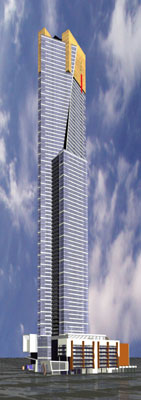Design and documentation of Eureka Tower meeting strict planning, construction, and financial controls
Budapest/Melbourne, February 28, 2002 – The 90-storey Eureka Tower, to be a stunning new landmark in Melbourne, Australia will be the tallest residential building in the world. It is also one of the largest building projects using the 3D Virtual Building™ concept for design and construction documentation.
 That approach by Fender Katsalidis (Aust) Architects (FKAU), known for their award-winning high-rise residential, commercial and public designs embellishing Australian cities, has allowed the exploration of design and construction solutions, meeting construction requirements with documentation created as a by-product of the design process.
That approach by Fender Katsalidis (Aust) Architects (FKAU), known for their award-winning high-rise residential, commercial and public designs embellishing Australian cities, has allowed the exploration of design and construction solutions, meeting construction requirements with documentation created as a by-product of the design process.
Located within the Southgate precinct of Melbourne, the Eureka Tower is immediately adjacent the Yarra River and the Southbank Promenade, the Arts precinct and the Crown Entertainment Centre. When complete, the building will spike 300 metres above Melbourne over an eleven-storey podium complex containing a car park, retail and office facilities. Distinguished among Melbourne’s residential towers, at its pinnacle is an observation complex featuring public areas and restaurant facilities.
The builder, Grocon Pty Limited, commenced construction in 2001, with completion expected in 2004. For such a large-scale project to be on schedule, close cooperation and efficient communication between architect and builder is essential.
“It was clear to us from the start that traditional approaches to design and documentation would not work effectively in meeting the needs of streamlined construction programs in an environment of strict financial and planning controls,” explains Nonda Katsalidis, principal and design director. “By exploiting the intelligence of the 3D virtual model, we have been able to not only provide construction documentation when needed by the builder, but to prototype the design options as part of that process.”
The practice uses Archicad® as their CADD software for design and documentation. According to FKAU Director of Planning David Sutherland, Archicad was selected by the practice as the software which provided the optimum balance of technological sophistication with user simplicity, and which encouraged a collaborative working environment that assisted in the coordination of architectural activities from design through to documentation.